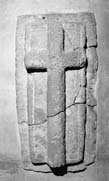Select a site alphabetically from the choices shown in the box below. Alternatively, browse sculptural examples using the Forward/Back buttons.
Chapters for this volume, along with copies of original in-text images, are available here.
Object type: Grave-cover
Measurements: L. 80 cm (31.5 in) W. 39 > 37.5 cm (15.4 > 14.8 in) D. > 10 cm (3.9 in)
Stone type: Greyish-yellow (10YR 8/3–4) pelletal shelly oolitic limestone, with ooliths of 0.4 to 0.6mm diameter, pellets around 1mm, and worn shell fragments including small spired gastropods, in a hard calcite matrix; no obvious layering of shell fragments. Upper Lincolnshire Limestone, Inferior Oolite Group
Plate numbers in printed volume: Ill. 430
Corpus volume reference: Vol 5 p. 291
(There may be more views or larger images available for this item. Click on the thumbnail image to view.)
This is a rather unusual, very slightly tapered, small grave-cover decorated simply in bold relief. The decorated portion is much smaller in area than the upper surface of the stone: thus there is a broad undecorated apron around the raised decorated part of the cover. This raised part of the cover stands 3cm proud of the apron and is demarcated by a roll-moulded border. In the centre of the panel thus created is a large A1 type cross in high relief and of semicircular section, projecting a maximum of 6cm above the panel in which it sits.
Appendix A item (stones dating from Saxo-Norman overlap period or of uncertain date).
There are no very good parallels for this piece within the county. It shares with a number of covers and markers the same motif of the bold cross in relief (e.g. Winterton 1, Ill. 388), but none of these has the same degree of relief carving or a cross of semicircular section, and similarly none has the surrounding apron of stone. Both of these features are unusual and suggest that, instead of being intended to sit flush with the ground, this cover was intended to project well above the surface. It might even have been the lid of an early 'chest' type monument – like the twelfth-century Lincoln group, for example (Stocker 1988) – and its use as the lid of an early chest may explain the apron, which might be needed if the stone were to fit over a structure beneath. The weathering may suggest that the monument was originally outside, although this could have occurred during a subsequent period of disuse. The lack of local parallels makes this piece somewhat difficult to date, but if it does belong to a monumental tradition of raised covers, or to a chest-like monument, then a date in the late eleventh or twelfth century is perhaps more likely than earlier.



